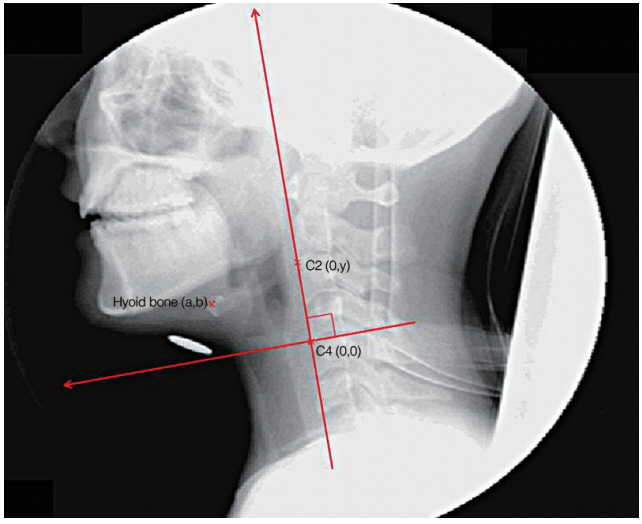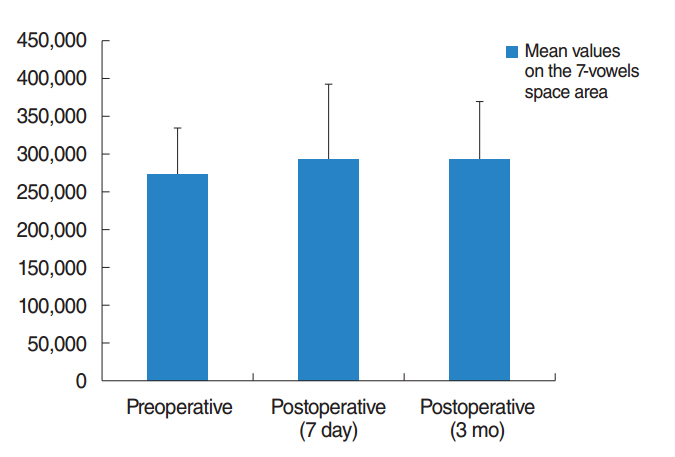Clin Exp Otorhinolaryngol.
2017 Jun;10(2):168-173. 10.21053/ceo.2015.01585.
Changes in Oral Vowel Sounds and Hyoid Bone Movement After Thyroidectomy
- Affiliations
-
- 1Department of Otolaryngology-Head and Neck Surgery, Research Institute of Clinical Medicine of Chonbuk National University-Biomedical Research Institute of Chonbuk National University Hospital, Jeonju, Korea. khhong@chonbuk.ac.kr
- 2Speech Therapy, Research Institute of Clinical Medicine of Chonbuk National University-Biomedical Research Institute of Chonbuk National University Hospital, Jeonju, Korea.
- KMID: 2380436
- DOI: http://doi.org/10.21053/ceo.2015.01585
Abstract
OBJECTIVES
Voice and speech alterations after total thyroidectomy may be associated with other extralaryngeal factors, such as neck muscle dysfunction and neck scar contracture. We evaluated the acoustic characteristics of oral vowel sounds and changes in hyoid bone movement before and after thyroidectomy.
METHODS
Twenty-nine female patients undergoing total thyroidectomy were included. Fundamental frequencies (Fo), formants and vowel space areas were evaluated before surgery and 7 days and 3 months after surgery to acoustically analyze the oral vowel sounds. Videofluoroscopic images were taken at the same times to evaluate hyoid bone movement.
RESULTS
The Fo levels of seven vowels decreased significantly after surgery. The vowel formant changes the F1 of vowel /[e]/ decreased significantly from baseline at 3 months postoperatively, and the F3 of vowel /[i]/ decreased significantly from baseline 7 days postoperatively. The change in the vowel space area was not observed. The Y coordinate of the vowels /[i]/ and /[e]/ decreased significantly from baseline 7 days postoperatively due to changes in hyoid movement.
CONCLUSION
The damage to the neck muscles after thyroidectomy changes in Fo, formant and hyoid bone position. These quantitative results could be used as basic data for voice management in patients who undergo thyroidectomy.
Keyword
Figure
Reference
-
1. Williams RG, Lesser TH, Foster M, Griffith G. Altered laryngeal function following thyroidectomy. Clin Otolaryngol Allied Sci. 1989; Aug. 14(4):281–3.
Article2. Sonninen A, Hurme P, Laukkanen AM. The external frame function in the control of pitch, register, and singing mode: radiographic observations of a female singer. J Voice. 1999; Sep. 13(3):319–40.
Article3. Sinagra DL, Montesinos MR, Tacchi VA, Moreno JC, Falco JE, Mezzadri NA, et al. Voice changes after thyroidectomy without recurrent laryngeal nerve injury. J Am Coll Surg. 2004; Oct. 199(4):556–60.
Article4. Bone SL, Vertigan AE, Eisenberg RL. Auditory-perceptual voice characteristics in pre-operative patients undergoing thyroid or parathyroid surgery. Folia Phoniatr Logop. 2012. 64(2):87.
Article5. Hong KH, Kim YK. Phonatory characteristics of patients undergoing thyroidectomy without laryngeal nerve injury. Otolaryngol Head Neck Surg. 1997; Oct. 117(4):399–404.
Article6. Lombardi CP, Raffaelli M, De Crea C, D’Alatri L, Maccora D, Marchese MR, et al. Long-term outcome of functional post-thyroidectomy voice and swallowing symptoms. Surgery. 2009; Dec. 146(6):1174–81.
Article7. Santosh M, Rajashekhar B. Perceptual and acoustic analysis of voice in individuals with total thyroidectomy: pre-post surgery comparison. Indian J Otolaryngol Head Neck Surg. 2011; Jan. 63(1):32–9.8. Keilmann A, Hulse M. Dysphonia after thyroidectomy without lesion of the recurrent nerve. Folia Phoniatr. 1992. 44(6):261.9. Kent RD. Anatomical and neuromuscular maturation of the speech mechanism: evidence from acoustic studies. J Speech Hear Res. 1976; Sep. 19(3):421–47.
Article10. Raphael EJ. Tongue position in rounded and unrounded front vowel pairs. Lang Speech. 1979; Jan. 22(1):37–48.
Article11. Vilkman E, Aaltonen O, Laine U, Raimo I. Intrinsic pitch of vowels: a complicated problem with an obvious solution? In: Gauffin J, Hammarberg B, editors. In : Gauffin J, Hammarberg B, editors. Vocal fold physiology. San Diego: Sigular Publishing Group;1991. p. 59–65.12. Vilkman E, Aaltinen O, Raimo I, Arajarvi P, Oksanen H. Articulatory hyoid-laryngeal changes vs. cricothyroid muscle activity in the control of intrinsic Fo of vowels. J Phon. 1989; Jan. 17:193–203.13. Ohala J. Speculation on pitch regulation. Phonetica. 1977; 34:310–2.14. Erickson D, Liberman M, Niimi S. The geniohyoid and the role of the strap muscle. Haskins Lab Status Rep Speech Res. 1977; Jan-Mar. SR-49:103–10.15. Hong KH, Kim HK, Kim YH. The role of the pars recta and pars oblique of cricothyroid muscle in speech production. J Voice. 2001; Dec. 15(4):512–8.
Article16. Beyer WH. CRC standard mathematical tables. 28th ed. Boca Raton, FL: CRC Press;1987.17. Hong KH, Yang YS, Lee HD, Yoon YS, Hong YT. The effect of total thyroidectomy on the speech production. Clin Exp Otorhinolaryngol. 2015; Jun. 8(2):155–60.
Article18. Nam HS, Beom J, Oh BM, Han TR. Kinematic effects of hyolaryngeal electrical stimulation therapy on hyoid excursion and laryngeal elevation. Dysphagia. 2013; Dec. 28(4):548–56.
Article19. Ishida R, Palmer JB, Hiiemae KM. Hyoid motion during swallowing: factors affecting forward and upward displacement. Dysphagia. 2002; Fall. 17(4):262–72.
Article20. Paik NJ, Kim SJ, Lee HJ, Jeon JY, Lim JY, Han TR. Movement of the hyoid bone and the epiglottis during swallowing in patients with dysphagia from different etiologies. J Electromyogr Kinesiol. 2008; Apr. 18(2):329–35.
Article
- Full Text Links
- Actions
-
Cited
- CITED
-
- Close
- Share
- Similar articles
-
- A cephalometric study in patients with obstructive sleep apnea after use of oral appliance
- A longitudinal positional changes of hyoid bone in Koreans with normal occlusion
- Evaluation of hyoid bone movements in subjects with open bite: a study with real-time balanced turbo field echo cine-magnetic resonance imaging
- Assessment of Oropharyngeal Dysphagia in Patients With Parkinson Disease: Use of Ultrasonography
- Effect of Decannulation on Pharyngeal and Laryngeal Movement in Post-Stroke Tracheostomized Patients





